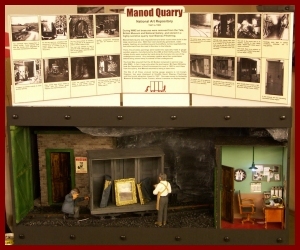
|
Click on any photo to enlarge in a new window
1/12 scale : 50mm gauge - Chris MacKenzie
During WW2 art treasures were removed from the Tate, British Museum and National Gallery, and stored in a highly secretive quarry near Blaenau Ffestiniog.
Manod Slate Quarry was requisitioned and brick rooms were built in the large cavernous area. With their own electricity generators, water supply, heating, air-conditioning and humidifiers, lorries negotiated the four mile track from the road to the door in the hillside.
There, the priceless paintings were loaded into specially made 2í gauge wooden wagons, manufactured by the LMS at their Derby works. These railway trucks were pushed by hand along the tunnels into one of the underground rooms. Any necessary repairs were then undertaken before being stored away hundreds of feet underground.
The Cold War ensured that the Art Bunker remained in service long after WWII. In fact, it was only when the land owner, Mr Owen Williams, took the Department of the Environment to court in 1983 to evict them from his quarry, that Manod returned to being a slate mine.
The fate of all these unusual narrow gauge wagons is not known. However, two were displayed at Gloddfa Ganol, Blaenau Ffestiniog, until the tourist attraction closed in 1997. One was moved to Amberley Museum & Heritage Centre, Sussex, where it remains on display today.

History
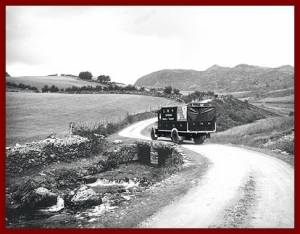
The paintings were transported in railway lorries.
Some reports state that the trucks were disguised as chocolate manufacturer deliveries.
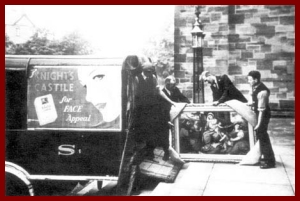
As the war went on, a tradition was introduced of taking one painting a month back to London to go on public display, then returning it to the quarry.
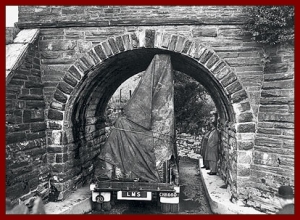
The Van Dyck portrait of Charles I took a long time to be manoeuvred under a nearby railway bridge.
The road was lowered 2Ĺ feet to allow the huge crate through. Even then, it only made it when the truckís tyres were deflated.
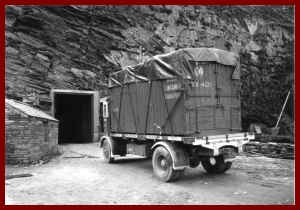
Another consignment approaches the main art repository entrance door.
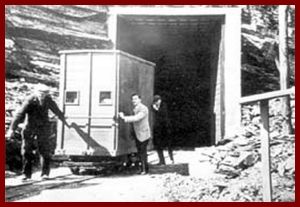
A wagon is pushed outside to meet another delivery
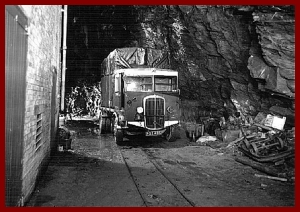
Often lorries were driven inside to unload onto the narrow gauge wagons, thus improving security.
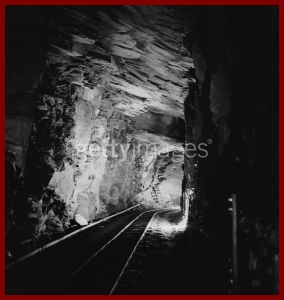
Inside, the wagons were pushed along a long tunnel from the reception area to the main chamber.
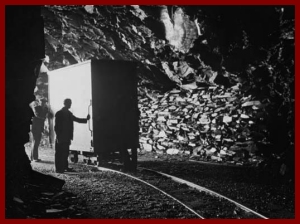
This main tunnel was widened to 13 feet high from the original 6 feet to allow for lorries and the railway wagons.
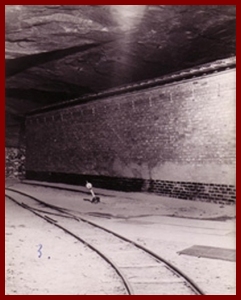
The narrow gauge railway system served all the chambers and enabled easy transportation.
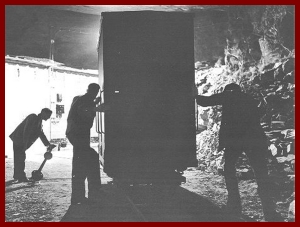
Although some internet sites state that a loco was used at the site, there is no evidence of this ever being used once the site was constructed. The limited photographs show only manpower.
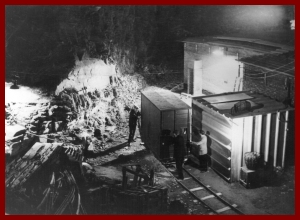
The roof of the cavern had to be regularly checked to limit falling debris. Repairs with chains were a regular occurrence.
Once built, there is no evidence of any other type of wagon being used -not even skips or trucks.
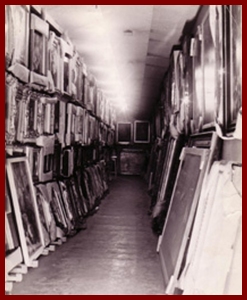
Paintings were kept in perfect conditions, stretched out in long galleries.
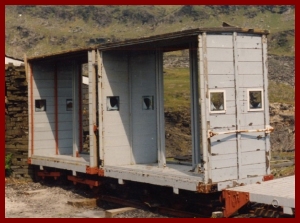
Two wagons were left to deteriorate at Gloddfa Ganol (a North Wales slate quarry tourist attraction)
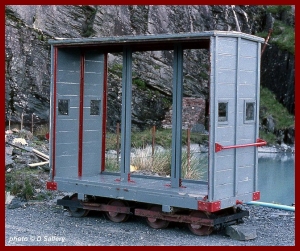
It is unknown if one of the wagons at Gloddfa Ganol was restored, or if this picture was of a third wagon.
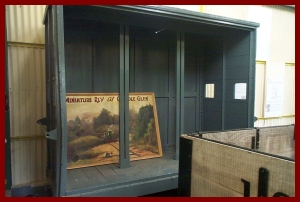
When Gloddfa Ganol closed in 1997, one wagon was moved to Amberley Museum & Heritage Centre, Sussex.
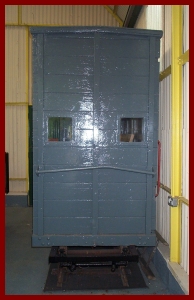
A very unusual, but very interesting, specialised railway wagon!

For more information I can strongly recommend the following book:
by Nick McCamley
ISBN: 9780850529180
Hardback 224 pages
Published: 6 June 2002
http://www.pen-and-sword.co.uk/Saving-Britains-Art-Treasures/p/335?product_id=335

The Model
|
In July 2011, the Telford Narrow Gauge model railway exhibition held a Micro Layout Competition. Only 300 square inches were allowed, but the scale had be 7/8" = one foot or 1" = 1 one foot (1:12th scale).
This seemed like the perfect excuse to build a static diorama of the Manod Quarry when used as the National Art Repository.
The scale of 1:12 was chosen and a track gauge of 50mm was decided upon, which would represent the real life 2' gauge.
|
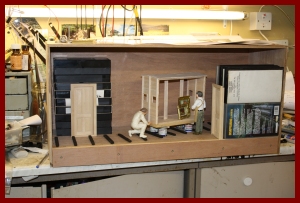
30" x 10" is very small for a layout in 1:12th scale!
Once a scale model was made of the surviving wagon at Amberley (see above), some model people were acquired to help try and work out what should go where. The old video boxes helped to give a visual understanding of where the buildings should go.
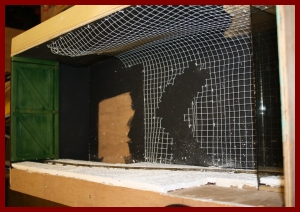
Once the track was down (very old Gauge 1 wooden sleepers and chairs re-drilled appropriately) work began on the scenery.
Normal wire mesh was stapled in place to give contours, and then wet plaster of paris modelling bandages were draped over, in the time honoured scenic fashion.
The track exiting the backscene to the left would be hidden by a huge wooden 'bomb blast' door, however the other side wasn't that easy...
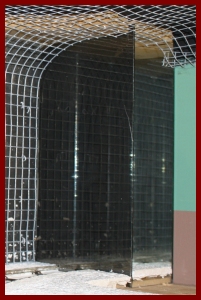
A leap of faith was made to try and create the optical illusion of a 'never ending tunnel'. This would be positioned behind the cut-a-way office, to give the illusion that the tunnel and the track went on for hundreds of yards (hopefully).
A normal mirror was acquired (the local Pound Shop) and cut to size. This was fixed to the right-hand backscene (double-sided carpet tape).
About 1.5 inches in front of it was fixed a normal thin piece of glass - I think it came from a picture frame no longer needed. Now the tricky bit...
I managed to blag an off-cut of mirrored window film from a friendly chap who fits it to office windows for a living (thanks Vinnie!). The theory is that when the light is brighter on the inside of the mirrored glass, an observer looking in sees straight through it as if it wasn't there. But when you look through the mirrored glass you look straight at the mirror. This reflects back to the mirror you're looking through, which reflects the mirror, which... ad infinitum.
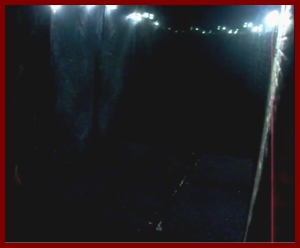
Despite me being lousy at photography, the image to the left hopefully shows the success. It worked! The 1.5 inches of track appeared to go on forever and the LED lamps hung on the wall like lanterns (two on one side, one on the other) were repeated to infinity and beyond.
Perhaps the trump card was putting the one-way mirror at a slight angle to the actual mirror. This made it look like the track and tunnel went round a gradual bend.
The bad thing about it? I'm sure that many people didn't look around the wagon and therefore didn't see this bit of modelling history being made. Perhaps I should have made it centre stage? (but then it probably wouldn't have worked as the viewing side of the one-way mirror would've been as bright as the middle section) (there is a light ratio needed of about 6:1)
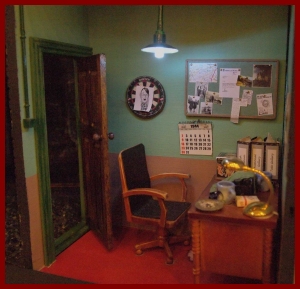
The Manager's Office to the right of the layout, in front of the 'never ending tunnel' trick.
This was furnished with dolls house furniture (sawn and stuck back together to make it fit) and posters printed from the internet.
Little finishing touches seemed to bring the scene alive - things like weathering the furniture, ash in the ash tray, a sketch of Hitler in front of the dart board, worn lino under the desk where feet would go, etc etc etc. The lamp shade is a party popper.
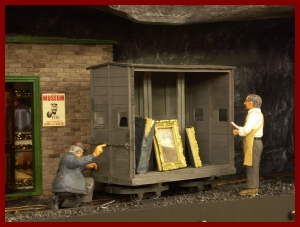
Dolls house pictures on the wagon made the scene more interesting. Some of these were wrapped in sheeting (coffee filters soaked in a PVA / water mix and suitably painted) whilst other frames were given the correct painting of the day.
The little storeroom to the left of the layout was jammed full of similar paintings.
The bloke with the clipboard was a re-painted dolls house resin character, whilst the man kneeling is a Tamiya pit crew member (with quite a bit of filler after repositioning arms and legs).
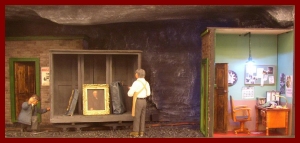
The finished module.
Unfortunately the 'layout' didn't come in the top three of the competition but this one wasn't really made to win. It is a subject that still fascinates me and I thoroughly enjoyed conducting the research, planning it all out and building the thing - especially the wagon. It also seems to be a subject that intrigues other people as there was always a crowd around it reading the information panels.
What's next to do? Make the man mechanical so he really pulls the wagon along? Nah! Back to 16mm scale! (may be)

A note about the Photographs
|
The pictures on this site have been taken from a number of web sites over several years. I saved them for my reference and they seemed too good not to use on this site.
If Iíve breached any particular copyright or not accredited them accordingly, then please get in touch and tell me what you want me to do. I can delete them straight away or mention all rights. Just let me know,
Thank you
|
| |
